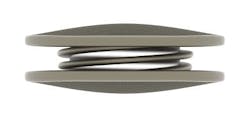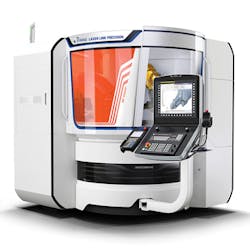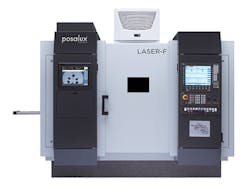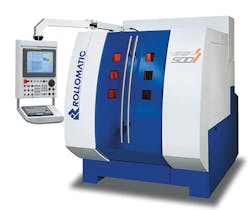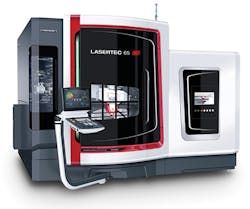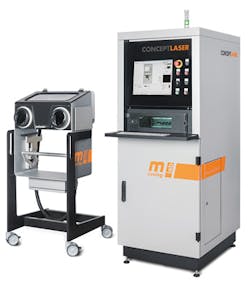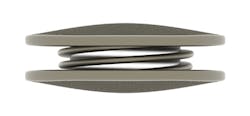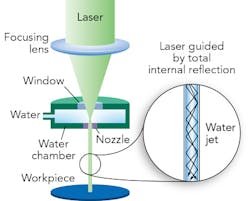Micromachining trends in Europe
European laser micromachining market is expected have double-digit growth in 2016
NITIN SHANKAR
Starting with niche applications, the laser micromachining segment is now in growth mode. Many of the early laser applications focused on machining materials such as carbides, ceramics, glass substrates, silicon, and synthetic diamonds. Laser micromachining systems were configured with highly accurate optics and motion control systems to manufacture precision parts such as stents and filters for medical applications, microfluidic components, tool inserts, watch gears, and injection nozzles with precision micro-bores. Now, laser micromachining is displacing electrical discharge machining (EDM) and other processes because it is capable of producing miniature parts with sharp features, without any heat damage.
Green lasers for diamond inserts
Presently, solid-state and fiber lasers are the workhorses for micromachining applications. Users have been able to tweak the parameters of solid-state lasers operating in the green wavelength (532nm) that emit short pulse durations in the nanosecond (10-9) range to get good results in machining silicon parts and synthetic diamond tool inserts.
EWAG AG uses a green laser source in a system for machining chemical vapor deposition (CVD) synthetic diamond inserts for cutting tools. Synthetic diamond tool inserts are very hard, resistant to abrasive wear, and have a high thermal conductivity. However, only laser technologies are capable of machining these materials.
The EWAG Laser Line Precision (FIGURE 1) can be described as a compact laser production center for diamond tools. Next to the laser machining cell, there is a robot cell with a FANUC six-axis robot that can pick a tool from a pallet and transport it to the clamping station. After machining, there is provision for dimensional inspection. It is a system designed for unmanned multi-shift operation.
Once the tool is clamped, a sensor probes the part and software automatically compensates for its positioning.
A patented Laser Touch Machining generates top quality cutting edges in an efficient manner. In this process, the five-axis CNC machine and the overlaid two-axis CNC laser beam guide can machine complex geometries in just one clamping operation. The green-wavelength laser source emits short pulse durations (1.5ns) with a fine laser focus diameter (15μm) suitable for the precision machining of CVD diamond plates.
For manufacturers of CVD diamond tools, this flexible laser machining center is suited for the automated production of small and large batches.
Femtosecond lasers for quality finishing
Market leaders TRUMPF and Rofin are offering commercial versions of ultrashort-pulse (USP) lasers in the picosecond (10-12) and femtosecond (10-15) range. Such USP lasers emit pulses that are shorter than the time needed for most energy diffusion processes within the atomic lattice. This technology does away with heat spreading to surrounding areas and the process is referred to as "cold."
The TRUMPF TruMicro 5025 Femto Edition and Rofin StarFemto laser sources operate with a 20W power, emitting ultrafast pulses in the 700–900fs range.
"We see femtosecond lasers gaining market share in the microprocessing of metals such as drilling of small holes," says Christof Siebert of TRUMPF. "In some cases, improved surface qualities can be reached by using ultrafast lasers."
Using such femtosecond laser sources, machine builders have developed mechanical platforms to achieve good results in terms of accuracy and finish.
The Posalux SA COMBI FEMTO-LASER multitasking machine combines milling and laser finishing (FIGURE 2). The USP laser source emits femtosecond pulses (230fs) for finishing micro-bores. Using this laser technology, the COMBI micromachining system can finish a bore diameter to a surface roughness of Ra = 0.05μm, which is equivalent to polishing.
One typical COMBI multitasking application is the machining of a fuel injection nozzle. Six nozzle holes (500μm) are milled in one station, and in parallel six nozzle spray holes (200μm) are laser-machined in the second station with a cycle time of 14s.
The above example shows how femtosecond laser operation can be integrated in a multitasking machine platform for optimal results.
Platforms for precision micromachining
One reason for the success of laser micromachining is that machine builders have been able to develop mechanical platforms capable of delivering accuracies in the micron range. The new generation of machines includes features such as laser scanners, cameras, and probes to ensure in-process controls.
The ROLLOMATIC LaserSmart 500 machining center (FIGURE 3) for the automated production of CVD diamond tools is an example of the mechanical features needed for accurate laser micromachining.
To ensure tool concentricity for cylindrical parts within 1μm, the LaserSmart 500 has a clamping system based on a centering V-block, which provides support to the tool shank. Once the part is clamped, a digital camera and 3D probe determine the exact position of the tool body and the brazed CVD insert within the body. All laser machining trajectories are accordingly calculated. The system uses a digital scanner to ensure that the geometry to be cut and the positioning of the laser beam are aligned.
A special cutting tool with profile and relief angles can be laser-finished to a surface roughness of Ra = 1μm within a cycle time of 12min.
This laser machining center fulfils the requirement of producing a batch of tools to micron precision. Unlike traditional processes, this is contactless machining with no tool wear or load bearing.
Additive manufacturing with multitasking machines
Up until now, additive technologies have used 3D printers to generate prototypes and small parts. The problem was that a second machining operation was needed to finish the part to the required precision.
DMG MORI has demonstrated how multitasking technology can be combined with additive manufacturing to machine a precision part in a single cycle.
The DMG MORI LASERTEC 65 3D (FIGURE 4) offers an innovative hybrid solution integrating additive manufacturing into a five-axis milling machine, thus providing the flexibility needed for the micromachining of small batches of precision parts.
The process uses metal deposition by powder nozzle, which is up to 10x faster than the generation from a powder bed. It alternates between laser part generation and milling to finish a part to the required precision.
Depending on laser and nozzle geometry, wall thicknesses from 0.1 to 5mm are possible.
The DMG LASERTEC 65, a fruitful collaboration between German and Japanese developers, demonstrates that additive manufacturing has a place in industrial laser micromachining.
Creative geometry for complex medical implants
When it comes to miniature component design, additive manufacturing can open up entirely new directions. Concept Laser has developed an additive manufacturing patented process known as LaserCUSING, made up of the letter C from CONCEPT Laser and the word FUSING (complete melting).
Using 3D CAD data, the LaserCUSING process generates components layer by layer. The segments of each individual layer—so-called islands—are worked through in a manner that significantly reduces stresses within the component. This allows solid objects to be generated with low warping.
The Concept Laser Mlab cusing R (FIGURE 5), equipped with a 100W fiber laser, can process titanium and titanium alloys. Tsunami Medical (Modena, Italy), a developer of various types of spinal implants, has installed a Mlab cusing R system.
Concept Laser's technology makes it possible to additively manufacture components for spine implants using titanium or titanium alloys. Surgeons use such implants to heal damaged spines.
One such component is a customized disc prosthesis that acts as a vertebral spacer to strengthen the spine (FIGURE 6). It consists of an upper shell and a lower shell connected by a double spring. The double spring is made of titanium with a silicone core for damping the movement of the spring. The design and spacing dimensions can be adjusted precisely to the patient's anatomy in accordance with the surgeon's specifications.
Using laser melting technology, this disc prosthesis is manufactured in a one-shot process, eliminating the need for downstream assembly processes.
A special feature of this titanium part lies in its geometry with partially different density distributions through embedded web-like structures. Thus, this part offers the biocompatibility of titanium with the desired elasticity of a plastic material.
Such implants can also be affordably manufactured in various dimensions depending on the anatomy of the patient, allowing for customized manufacturing.
Waterjet-guided laser
The Swiss-built Synova LCS 50-5 machine, equipped with its proprietary Laser MicroJet (LMJ), employs a waterjet-guided laser cutting technology to allow machining with nearly no heat damage. In this system, the laser is entirely guided within the water jet, similar in principle to an optical fiber.
In the Laser MicroJet system, a laser beam—passing through a pressurized water chamber—is focused into a nozzle (FIGURE 7). The low-pressure water jet emitted from the nozzle guides the laser beam by means of total internal reflection at the water/air interface. The waterjet-guided laser beam is cylindrical and its diameter, depending on the nozzle, can be 40 or 50μm. The laser power required is <20W. While the principle looks simple, years of experimentation were required to fine tune the process.
In comparison to conventional "dry" lasers, the Synova waterjet-guided laser offers many advantages for micromachining applications.
The main benefit is the cylindrical laser beam of the Laser Microjet, which results in parallel kerf walls and allows a cutting depth up to 50mm. Focusing or distance control is not necessary. By contrast, a conventional focused laser beam has a short working range of just a few millimeters because of beam divergence, and requires precise focus distance control.
Another advantage of the waterjet-guided laser is that it ensures a better surface finish. The Laser MicroJet uses the heat of the laser beam to cut while the water jet provides a cooling effect. As a result, the hot carbon vapor generated during cutting is constantly being evacuated by the flow of water resulting in a clean and smooth surface.
The LCS 50-5, with its five-axis machining capability, is particularly suited for manufacturing CVD diamond tool inserts. A polycrystalline diamond (PCD) tool insert sample cut by LMJ laser is free of cavities and has a minimal roughness (Ra = 0.2 μm).
With a five-axis CNC controller and built-in vision system, the LCS 50 is suited for micromachining of CVD diamond tool inserts to the required precision and surface quality specifications. Chinese CVD diamond tool insert manufacturers have already placed orders for 10 LCS 50-5 systems, and the LMJ laser technology has proven its worth in this sector.
Outlook
The above examples have shown that the combination of new laser sources and improved mechanical platforms are the driving forces for the growth of the industrial laser micromachining market.
Certain trends to be observed in the micromachining sector include:
- Market reports project an annual growth rate of 20% for the USP laser market—with USP laser technology, any type of material can be removed with high precision and minimal heat damage;
- Multitasking machines, which combine conventional and laser processing for higher productivity and better quality, will gain acceptance in the automotive sector;
- Multitasking machines, which combine laser additive manufacturing and conventional machining, will become economically feasible for the manufacture of complex parts in the aerospace and medical sectors; and
- Waterjet-guided lasers (or wet lasers) will be increasingly used for 3D or five-axis machining of parts where higher ablation rates are required.
For manufacturers confronted with the task of making hard-to-machine precision parts, it is worth considering a laser micromachining option. Maybe there is a laser in their future!
ACKNOWLEDGEMENTS
Laser Touch Machining is a registered trademark of EWAG AG, LaserCUSING is a registered trademark of Concept Laser, and Laser MicroJet is a registered trademark of Synova.
NITIN SHANKAR([email protected]) is a consultant located in Ecublens, Switzerland.
